
A textile is a flexible material made by creating an interlocking network of yarns or threads, which are produced by spinning raw fibres into long and twisted lengths. Textiles are then formed by weaving, knitting, crocheting, knotting, tatting, felting, bonding, or braiding these yarns together.
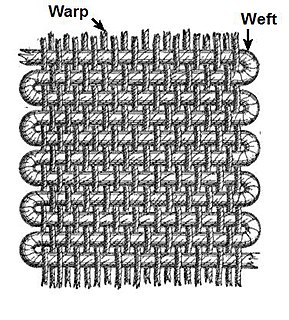
Weaving is a method of textile production in which two distinct sets of yarns or threads are interlaced at right angles to form a fabric or cloth. Other methods are knitting, crocheting, felting, and braiding or plaiting. The longitudinal threads are called the warp and the lateral threads are the weft, woof, or filling. The method in which these threads are inter-woven affects the characteristics of the cloth. Cloth is usually woven on a loom, a device that holds the warp threads in place while filling threads are woven through them. A fabric band that meets this definition of cloth can also be made using other methods, including tablet weaving, back strap loom, or other techniques that can be done without looms.
Ikat is a dyeing technique originated from Indonesia used to pattern textiles that employs resist dyeing on the yarns prior to dyeing and weaving the fabric.

Warp and weft are the two basic components used in weaving to turn thread or yarn into fabric. The lengthwise or longitudinal warp yarns are held stationary in tension on a frame or loom while the transverse weft is drawn through and inserted over-and-under the warp. A single thread of the weft crossing the warp is called a pick. Terms vary. Each individual warp thread in a fabric is called a warp end or end.

A Persian carpet or Persian rug, also known as Iranian carpet, is a heavy textile made for a wide variety of utilitarian and symbolic purposes and produced in Iran, for home use, local sale, and export. Carpet weaving is an essential part of Persian culture and Iranian art. Within the group of Oriental rugs produced by the countries of the "rug belt", the Persian carpet stands out by the variety and elaborateness of its manifold designs.
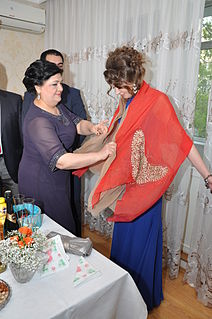
A shawl is a simple item of clothing, loosely worn over the shoulders, upper body and arms, and sometimes also over the head. It is usually a rectangular or square piece of cloth, which is often folded to make a triangle, but can also be triangular in shape. Other shapes include oblong shawls.
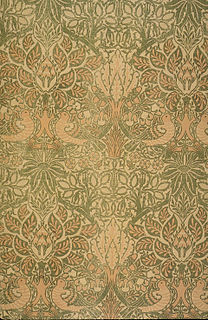
Double cloth or double weave is a kind of woven textile in which two or more sets of warps and one or more sets of weft or filling yarns are interconnected to form a two-layered cloth. The movement of threads between the layers allows complex patterns and surface textures to be created.

The Inca society was the society of the Inca civilization in Peru. The Inca Empire, which lasted from 1438 to 1533 AD, represented the height of this civilization. The Inca state was known as the Kingdom of Cusco before 1438. Over the course of the empire, the rulers used conquest and peaceful assimilation to incorporate a large portion of western South America, centered on the Andean mountain ranges. The empire proved relatively short-lived, however: by 1533, Atahualpa, the last Sapa Inca (emperor) of the Inca Empire, was killed on the orders of the conquistador Francisco Pizarro, marking the beginning of Spanish rule. The last Inca stronghold, the Neo-Inca State in Vilcabamba was conquered by the Spanish in 1572.
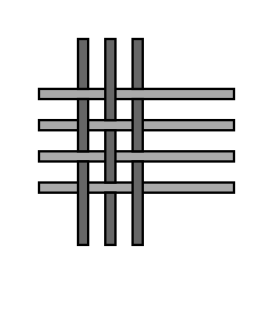
Plain weave is the most basic of three fundamental types of textile weaves. It is strong and hard-wearing, and is used for fashion and furnishing fabrics.

Anatolian rug is a term of convenience, commonly used today to denote rugs and carpets woven in Anatolia and its adjacent regions. Geographically, its area of production can be compared to the territories which were historically dominated by the Ottoman Empire. It denotes a knotted, pile-woven floor or wall covering which is produced for home use, local sale, and export. Together with the flat-woven kilim, Anatolian rugs represent an essential part of the regional culture, which is officially understood as the Culture of Turkey today, and derives from the ethnic, religious and cultural pluralism of one of the most ancient centres of human civilisation.

Silk in the Indian subcontinent is a luxury good. In India, about 97% of the raw mulberry silk is produced in the Indian states of Karnataka, Andhra Pradesh, Tamil Nadu and West Bengal. Mysore and North Bangalore, the upcoming site of a US$20 million "Silk City", contribute to a majority of silk production. Another emerging silk producer is Tamil Nadu where mulberry cultivation is concentrated in Salem, Erode and Dharmapuri districts. Hyderabad, Andhra Pradesh and Gobichettipalayam, Tamil Nadu were the first locations to have automated silk reeling units.
The manufacture of textiles is one of the oldest of human technologies. To make textiles, the first requirement is a source of fibre from which a yarn can be made, primarily by spinning. The yarn is processed by knitting or weaving, which turns yarn into cloth. The machine used for weaving is the loom. For decoration, the process of colouring yarn or the finished material is dyeing. For more information of the various steps, see textile manufacturing.

African textiles are textiles from various locations across the African continent. Across Africa, there are many distinctive styles, techniques, dyeing methods, and decorative and functional purposes. These textiles hold cultural significance and also have significance as historical documents of African design.
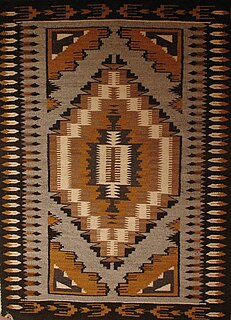
Navajo rugs and blankets are textiles produced by Navajo people of the Four Corners area of the United States. Navajo textiles are highly regarded and have been sought after as trade items for over 150 years. Commercial production of handwoven blankets and rugs has been an important element of the Navajo economy. As one expert expresses it, "Classic Navajo serapes at their finest equal the delicacy and sophistication of any pre-mechanical loom-woven textile in the world."

The Andean textile tradition once spanned from the Pre-Columbian to the Colonial era throughout the western coast of South America, but was mainly concentrated in Peru. The arid desert conditions along the coast of Peru have allowed for the preservation of these dyed textiles, which can date to 6000 years old. Many of the surviving textile samples were from funerary bundles, however, these textiles also encompassed a variety of functions. These functions included the use of woven textiles for ceremonial clothing or cloth armor as well as knotted fibers for record-keeping. The textile arts were instrumental in political negotiations, and were used as diplomatic tools that were exchanged between groups. Textiles were also used to communicate wealth, social status, and regional affiliation with others. The cultural emphasis on the textile arts was often based on the believed spiritual and metaphysical qualities of the origins of materials used, as well as cosmological and symbolic messages within the visual appearance of the textiles. Traditionally, the thread used for textiles was spun from indigenous cotton plants, as well as alpaca and llama wool.
Textile manufacturing is one of the oldest human activities. The oldest known textiles date back to about 5000 B.C. In order to make textiles, the first requirement is a source of fibre from which a yarn can be made, primarily by spinning. The yarn is processed by knitting or weaving to create cloth. The machine used for weaving is the loom. Cloth is finished by what are described as wet process to become fabric. The fabric may be dyed, printed or decorated by embroidering with coloured yarns.

The textiles of Mexico have a long history. The making of fibers, cloth and other textile goods has existed in the country since at least 1400 BCE. Fibers used during the pre-Hispanic period included those from the yucca, palm and maguey plants as well as the use of cotton in the hot lowlands of the south. After the Spanish conquest of the Aztec Empire, the Spanish introduced new fibers such as silk and wool as well as the European foot treadle loom. Clothing styles also changed radically. Fabric was produced exclusively in workshops or in the home until the era of Porfirio Díaz, when the mechanization of weaving was introduced, mostly by the French. Today, fabric, clothes and other textiles are both made by craftsmen and in factories. Handcrafted goods include pre-Hispanic clothing such as huipils and sarapes, which are often embroidered. Clothing, rugs and more are made with natural and naturally dyed fibers. Most handcrafts are produced by indigenous people, whose communities are concentrated in the center and south of the country in states such as Mexico State, Oaxaca and Chiapas. The textile industry remains important to the economy of Mexico although it has suffered setback due to competition by cheaper goods produced in countries such as China, India and Vietnam.
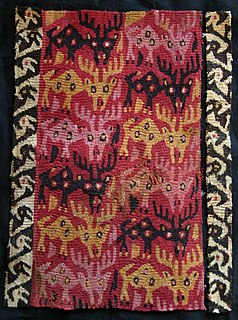
Textile arts of indigenous peoples of the Americas are decorative, utilitarian, ceremonial, or conceptual artworks made from plant, animal, or synthetic fibers by native peoples of both North and South America.
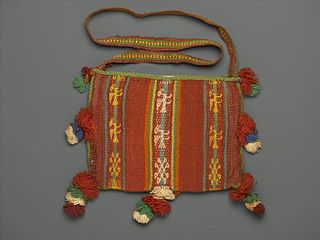
A chuspas is a pouch that is used to carry coca and cocoa leaves, used primarily in the Andean region of South America. Both textiles and coca are very important to the people in Andean South America. These chuspas are a vital piece of culture and are especially important to combat the bitter cold in the mountainous zones of the Andes. These bags are also a way to showcase the cloth which in itself is a primary artistic medium. Highland textiles are traditionally woven from the hair of native camelids, usually the domesticated alpacas and llamas, and more rarely, wild vicuña and guanaco. These pouches are important symbols of social identity. As part of this tradition, chuspas show to the rest of their people how skilled they are in weaving. They can express their artistic skills and display their cultural affiliation by creating these chuspas.
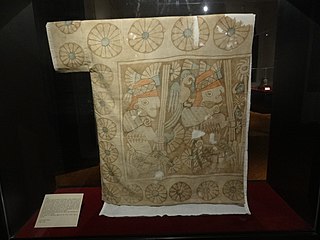
Uncu (Unku) was a men's garment of the Inca Empire. It was an upper-body garment of knee-length; Royals wore it with a mantle cloth called ''yacolla.'' Women wore a long dress known as an anaku.
















